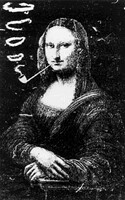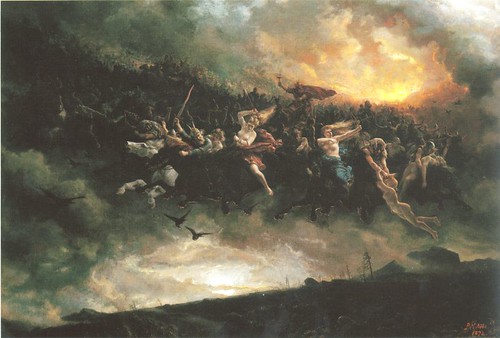In early 2005, Fernando Botero revealed a series of 50 paintings (Google Gallery) that graphically represent the controversial Abu Ghraib incident, expressing the rage and shock that the incident provoked in the artist. The works were initially presented in Italy, Germany and Greece. In 2006, they had their first showing in the United States. In 2007, the Abu Ghraib series was exhibited at the University of California in Berkeley. Botero has stated that he does not plan to sell the paintings, but instead intends to donate them to museums as a reminder of the events depicted within. Are these on display somewhere now?
Category Archives: art
Introducing Morbid Anatomy
Morbid Anatomy is a new blog dedicated to anatomy, which describes itself as “Surveying the Interstices of Art and Medicine, Death and Culture.”
An example of one of the major artists of anatomica: d’Agoty

Anatomie des parties de la génértion de l’homme et de la femme
Paris, 1773. Colored mezzotint. National Library of Medicine
image sourced here.
Karen Finley video
[Youtube=http://www.youtube.com/watch?v=b7Kkl1D1QRA&]
Karen Finley interviewed by V. Vale for the RE/Search series PRANKS!.
Scherzo infernal
Scherzo infernal (1984) – Walerian Borowczyk
Scherzo infernal (1984) is a short animated French film by Walerian Borowczyk narrated by Yves Robert and produced by Anatole Dauman‘s Argos Films. Beware when watching the current Youtube version of this film, the descriptive text has gotten mixed up with the descriptive text of Michel Follin‘s Ligeti documentary. In reality, the score of this short was composed by Bernard Parmegiani.
Proto-performance artists
‘Augmented’ Mona Lisa (1882) by Sapeck
Sapeck (Eugène Bataille) (born in Mans in 1854) was a French proto–performance artist who was known to travel the streets with his head painted blue. In the first show of the Incoherents in 1882, he contributed an ‘augmented’ Mona Lisa (Mona Lisa smoking a pipe) that directly prefigures the famous Marcel Duchamp image L.H.O.O.Q. of 1919.
Speaking of Duchamp, Ombres Blanches recently wrote Duchamp’s Dahlia or The Man Ray Mystery, an essay on the possible inspiration of Duchamp’s Etant donnés by the Black Dahlia murder.
Fantasmagorie
[Youtube=http://www.youtube.com/watch?v=aEAObel8yIE]
Fantasmagorie (1908) – Émile Cohl
Émile Cohl (January 4, 1857 – January 20, 1938), born Émile Eugène Jean Louis Courtet, was a French caricaturist of the largely-forgotten Incoherent Movement, cartoonist, and animator, called “The Father of the Animated Cartoon” and “The Oldest Parisian”.
Émile Cohl began drawing cartoon strips and created a film in 1908 called Fantasmagorie. The film largely consisted of a stick figure moving about and encountering all manner of morphing objects, such as a wine bottle that transforms into a flower. There were also sections of live action where the animator’s hands would enter the scene. The film was created by drawing each frame on paper and then shooting each frame onto negative film, which gave the picture a blackboard look.
Cohl made Fantasmagorie from February to May or June 1908. This is considered the first fully animated film ever made. It was made up of 700 drawings, each of which was double-exposed, leading to a running time of almost two minutes. Despite the short running time, the piece was packed with material devised in a “stream of consciousness” style. It borrowed from J. Stuart Blackton in using a “chalk-line effect”, having the main character drawn by the artist’s hand on camera, and the main characters of a clown and a gentleman (this taken from Blackton’s “Humorous Phases of Funny Faces”). The film, in all of its wild transformations, is a direct tribute to the by-then forgotten Incoherent movement. The title is a reference to the “fantasmograph“, a mid-nineteenth century variant of the magic lantern that projected ghostly images that floated across the walls.
“Fantasmagorie” was released on August 17, 1908.
Fascinating.
One more.
[Youtube=http://www.youtube.com/watch?v=X-Wsv3FgLBE]
The Automatic Cleaning Company
HER LOVER one day takes O for a walk
Parc Monceau by Monet
Monceau Park (1878) – Claude Monet
In search of Borgesian elements in Story of O.
From the opening lines of Story of O:
- “HER LOVER one day takes O for a walk in a section of the city where they never go – the Montsouris Park, the Monceau Park.”
Where did her lover take her? To the Monceau Park or the Montsouris Park? Or both?
I’ve written about O here.
Somewhat related linkcandy: sinnliches.ch and and accompanying Google gallery (nsfw).
Henri Landier art
I’ve been very much impressed by Pierre Mac Orlan painted by Henri Landier found on a Le copain de Doisneau, a blog dedicated to Robert Giraud.
Schreber’s Fantastic Beasts
Schreber’s Fantastic Beasts:
“In 1774 Johann Christian Dan Schreber authored a multivolume set of books entitled Die Saugthiere in Abbildungen nach der Natur mit Beschreibungen. Focusing on mammals of the world, these books were lavishly illustrated with 755 hand-colored plates. There was a slight problem though: in most instances the artists had never seen the animals they were rendering onto paper. Explorers would return from their travels and describe the animals in question to the artists. The end result was that some of the drawings, though representing real animals, looked more like they had come from someone’s nightmares.” —http://www.nhm.org/research/libraries/beasts/index.html
A phantasmal group of huntsmen
The wild hunt (1872) by Peter Nicolai Arbo
The Wild Hunt was a folk myth prevalent in former times across Northern, Western and Central Europe. The fundamental premise in all instances is the same: a phantasmal group of huntsmen with the accoutrements of hunting, horses, hounds, etc., in mad pursuit across the skies or along the ground, or just above it. It is often a way to explain thunderstorms.




